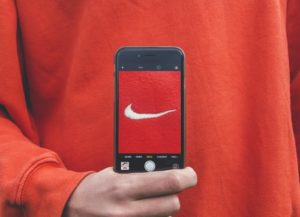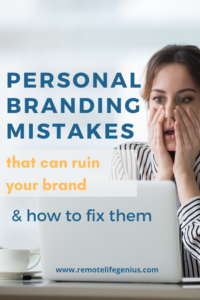 Your brand has the power to separate you from the competition and create customer loyalty. Without it, you might find yourself stuck in the hamster wheel of always fighting for customers.
Your brand has the power to separate you from the competition and create customer loyalty. Without it, you might find yourself stuck in the hamster wheel of always fighting for customers.
So, what exactly is a personal brand?
To simplify, your personal brand comes down to the thoughts and feelings that people have when they think of you and/or your business. Therefore, it is a combination of how you present yourself to your audience AND their experience working with you.
However, it takes more than satisfied customers to establish a strong personal brand. Establishing your personal brand requires a process known as personal branding.
Personalbrand.com defines personal branding as follows:
“The conscious and intentional effort to create and influence public perception of an individual by positioning them as an authority in their industry, elevating their credibility, and differentiating themselves from the competition, to ultimately advance their career, increase their circle of influence, and have a larger impact.”
If you skip this process, your brand will be fully defined by the experiences that other people have. To put it bluntly, this is too risky for something that means a lot to your business.
For example, it’s highly unlikely that each of your clients and colleagues will have the exact same experience with you. And furthermore, they don’t know what’s important to your brand if you don’t tell them.
The truth is this. You have to be a part of shaping and influencing your brand, otherwise, you give up all control of how people perceive you.
If you’ve already started working on your personal brand, you’re on the right track! Much like your business, it’s a journey not a destination.
And, like any journey, there are obstacles, pitfalls, and dead ends. Personal branding mistakes can be extremely costly to your business. But, when you get it right, it’s the wind in your sails.
This guide walks you through the most common (and costly) personal branding mistakes that beginners make, and, more importantly, what you can do to avoid them. This guide will help you make the most of your website and social media platforms and create a strong brand around your business.
If you are still working on your site or have yet to start, you can enroll in our 5-Day Website Creator Course. In addition to WordPress video tutorials, the course includes a day of personal branding steps.
The course is available free for a limited time, enroll today for lifetime access to the content.
Page Contents
1. Cheap Logos/Visuals
We live in a world where images and visuals rule perception. Here are some stats that show the awesome power of visual marketing:
- A whopping 90% of the information processed by our brains is visual
- Our brains process images 60,000x faster than text
- More than half of all web visitors spend less than 15 seconds reading words on a page
What do all these numbers mean? Images have much more impact than words. People are drawn to them, they process them faster, and they remember them more.
To put this in the context of your brand, this means there are elements of your brand that you can (and should) create yourself, but your logo and visuals is not one of them. There is, however, one exception. If you’re a graphic designer (or a great artist), by all means, create your own logo.
But, for the rest of us that aren’t professional image creators, it’s best to find one.

The power of a good logo can’t be underestimated. For example, the Nike logo was created for $35 by graphic designer Carolyn Davidson in 1971. More than 35 years later, in 2020, the Nike brand and its iconic swoosh are worth more than $34 million.
If you spend money on any part of your brand, it should be your logo.
How to avoid it
If you’re a personal brand just getting started, you don’t need to hire a branding agency or spend 100s of dollars on logo creation. Having a professional logo created is easier than you might think.
Instead, you can hire a freelance graphic designer to create a logo for you. Fiverr is one of the best freelance websites for this. You can search for different logo design services on their site and find a designer that fits your style and budget.
You’ll want a square or circular logo for use on profile images and websites. You may also want a longer version of your logo that includes your name or the name of your personal brand. Some providers may also include custom email signatures in their services.
Additionally, depending on the rest of your design you may want a black or white version of your logo for some documents. Be sure to ask for an image file with a clear background so you can use your logo on a variety of other designs such as your website, business cards, and social media posts.
But, before you go out and hire someone to do your logo, work through the rest of the steps in this guide so that you know exactly what to ask for.
2. Not Creating a Style Guide / Lacking Consistency
Strong personal brands are consistent over time. Take any famous person with a known “personal brand” and try this exercise. Google them, and see what comes up. You’ll see many consistencies in their image.
Exercise #1 – Researching existing brands
To demonstrate, Google search Mark Zuckerberg. You don’t see him in a t-shirt one day, a tuxedo the next, and a Gucci tracksuit later on. Nope, you see him in blue t-shirts or plain suits.

In fact, before you googled him, you probably already knew what to expect in the results.
That’s the power of consistency over time. In each of the top images, he has short hair, a cool-toned t-shirt or a suit, and almost always a blue background.
This doesn’t mean that you can’t ever change, but you can only build a brand image if you’re consistent. Elements like the color blue as well as Mark’s cropped haircut help establish his personal brand. Likewise, the colors, fonts, and even the words you use in every part of your work reinforce your brand.
To put it another way, inconsistent people appear disorganized and unprofessional online. If your potential clients look at you and sense a lack of consistency in your presence, they’ll assume that applies to the work you create.
How to avoid it
Create a simple style guide for yourself at the beginning. A good style guide will have two parts: a visual guide and a written personality guide. The written personality guide sets general rules for the tone and style of your writing.
Exercise #2 – Style guides
Your visual style guide includes:
- Your logo (and logo variations)
- A color scheme
- A font scheme
Your written style guide includes:
- A few words to describe your tone of voice
- A common format for dates and times
- Formatting for quotes and citations
- Which abbreviations you use
- Formatting guidelines (max # of fonts, margins, heading styles)
Neither of these guides should take you very long. In fact, you can write up both of them in a day or less. Focus on simplicity, and don’t create too many rules.

Finally, when thinking about consistency, there’s one important element to consider. People have already formed connections between certain colors, images, and words.
You want to leverage the natural associations that people already have. What this means, is that your branding choices should be consistent with existing expectations.
For instance, do some quick research on colors and images already associated with your values. Here’s an exercise that will help.
Exercise #3 – Leveraging existing associations
- Write down your top 3 values (or 3 words you want people to associate with your brand)
- Go to Google Images and search for the first word
- Note what colors and image themes pop up here
- Repeat for the other 2 words
By doing this, you can find symbols, images, and colors that will reinforce the personal brand that you want. We recommend doing this step before you work with a designer for your logo so you can be prepared with ideas and color preferences.
When doing research for your written style guide, you have a couple of options. One way to approach it is to research the standard for the industry that you want to work in or work with. Otherwise, if you don’t have a specific industry, find a few brands with values that you like, and see which grammar/writing rules they follow.
No matter what you choose, the most important part is staying consistent. Keep your style guides in concise documents and make sure they are readily accessible.
Consistency is especially important when creating your own website. In other words, your website is the home of your brand and should be treated with special attention. If you are still working on your site or have yet to start, you can enroll in our 5-Day Website Creator Course. In addition to WordPress video tutorials, the course includes a day of personal branding steps.
The course is available free for a limited time, enroll today for lifetime access to the content.
3. Hiding Your True Self / Presenting a False Narrative
Your personal brand should separate you from your competition and show off your unique strengths. If you try to be someone else, guess what? You won’t be able to compete. You can’t out-Beyonce Beyonce. But, you can be the market leader in being you.
 Furthermore, people today have a sixth sense for authenticity. They know when you’re not being real, and then they don’t trust you. A strong personal brand is all letting potential clients get to know you and building trust in the process.
Furthermore, people today have a sixth sense for authenticity. They know when you’re not being real, and then they don’t trust you. A strong personal brand is all letting potential clients get to know you and building trust in the process.
Don’t choose your values solely on what you think your clients want to hear. Nobody likes a suck-up. Make sure you present values that you actually believe in.
To clarify, your brand doesn’t have to be everything about you, but it should reflect your personality and your work.
How to Avoid It
Don’t lie, sugar coat, or exaggerate. Just squash the temptation in the beginning. Be yourself.
Here’s an exercise to help you narrow down the specifics.
Exercise #4 – Verifying values and assumptions
Choose a set of words, values, or emotions that you want people to associate with you. These should be things that you believe in, and they should be reflected in your work.
Ask your closest friends and family which top three values they relate to you. Did their answers match yours? If not, figure out where the disconnect comes from.
Another exercise you can do is to use defining your brand by contrast. List all the things that are the opposite of your personality and values. Take a look at a few competitors, figure out what you have in common with them and what’s different about you.
Your list of unique traits will be the foundation for your personal brand. When your brand is based on values, it will be easy to maintain authenticity and consistency.
4. Not Connecting with Your Audience/Not positioning
 This may seem to contradict #3, be yourself. But, hear me out. Your values and your personality should be your own. Ideally, you want to pick a target industry or niche that matches your values. However, if you can’t communicate effectively to your audience, your brand doesn’t matter.
This may seem to contradict #3, be yourself. But, hear me out. Your values and your personality should be your own. Ideally, you want to pick a target industry or niche that matches your values. However, if you can’t communicate effectively to your audience, your brand doesn’t matter.
Your personal brand is shaped by your identity, but it’s not all about you. You don’t exist in a vacuum. Individuals with weak personal brands stop at step three. They don’t think about others, it’s all about them.
If you know who you are, but you can’t demonstrate that you can solve someone’s problem, you become irrelevant.
How to Avoid It
Do your research. Understanding your audience is the first step in marketing, and if you skip it, all your other work goes to waste.
Get to know your audience and imagine a day in their lives. What does the perfect problem-solver look like from their point of view?
In terms of branding, it all comes down to knowing how to speak to your audience. You need to know:
- Is there a set of lingo/slang they use?
- Can you name their biggest stressors?
- Do they have common fears?
- What problems do they have?
Ultimately your brand is positioned in terms of the problem that you solve and who you solve it for. Empathetic brands are strong brands.
5. Lacking Confidence/Not Highlighting Your Success
As mentioned before, an amazing personal brand highlights individual strengths and builds trust. If you don’t have a confident brand, you don’t inspire others to have confidence in you. Namely, you don’t build trust.
Weak brands come across as unsure. If they could talk, they’d say “umm” every other word. On the other hand, strong brands state their value clearly and confidently. They say, “I trust myself, you should too.”
That is to say, the colors and values that you choose to represent your brand are important, but they won’t take you across the finish line if you lack confidence. People with weak or lazy brands believe that a logo and a pretty website is enough. But, they shy away from clear value statements and testimonials.
In the end, they have a good-looking site but they don’t build trust. The brand becomes a pretty face, not the driving force behind a productive business.
How to Avoid It
 Learn to reframe the idea of “selling yourself”. Don’t think of yourself as a product. Think of yourself as the solution, the only solution. For more tips on pitching your services, check out How to Pitch Your Freelance Services – 5 Elements of Amazing Pitches.
Learn to reframe the idea of “selling yourself”. Don’t think of yourself as a product. Think of yourself as the solution, the only solution. For more tips on pitching your services, check out How to Pitch Your Freelance Services – 5 Elements of Amazing Pitches.
Once again, it helps to step into the shoes of your potential customers. Imagine that you are your ideal client. You’re ready to hire a freelancer to run your business. What are their biggest worries? What reassurances can you provide? Make a list.
Use your list to frame your strengths in the forms of guarantees and reassurances. You want your client to feel good about hiring you. Get comfortable stating your value plainly, without apologies or words that take away strength. (You know them as words like, “can”, “maybe”, “might”, and “somewhat.”)
In addition to stating your own value, look for ways that other people can help you sell yourself. Specifically, you can use testimonials and professional awards or certifications. Seek out proof points that make someone excited about hiring you and put these on your website.
In Conclusion – One Final Caveat
Your clients want to work with someone that they like, know, and trust. Your personal brand is the tool that helps them get to know you and trust you. With this in mind, it’s essential to use the process of personal branding to establish a strong personal brand as a freelancer.
At the same time, remember that the process of personal branding is not the be all end all. Your brand is also made of how people remember you, and they will remember the way you made them feel. Support your brand with easy communication and high-quality work.
Over time, a strong personal brand will begin to have a snowball effect on your business. You’ll retain more existing clients and attract more clients who seek you out.
There are many common pitfalls of personal branding, but perhaps the biggest one is not doing it at all. Avoiding the process means giving up any control over how others perceive you. Your business and your lifestyle are too precious to leave to chance.
Want to save these tips? Pin the article!





